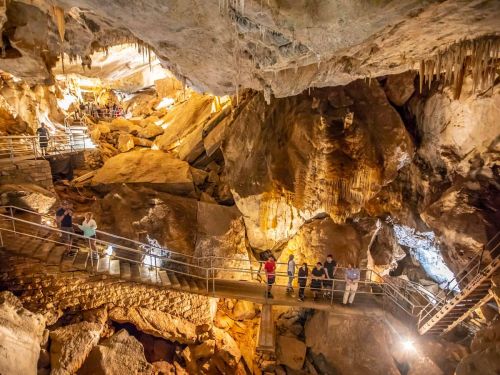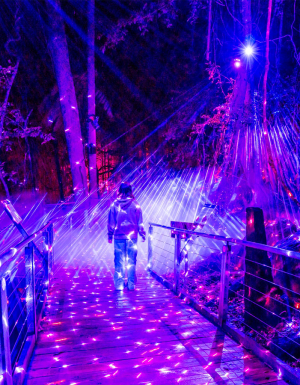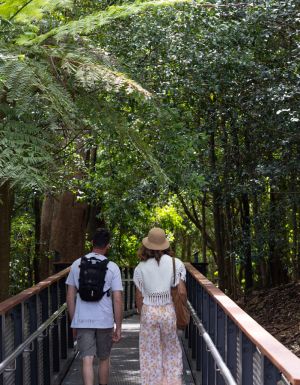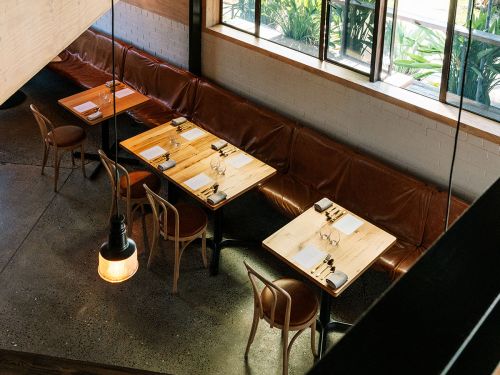A vast and ancient network of limestone chambers, Jenolan Caves is an unmissable Blue Mountains highlight.
Whether you’re a fan of geology, mythology or simply want to go underground, Jenolan Caves will ignite both your scientific fascination and wild imagination. The solidified beauty of stalactites, stalagmites and limestone structures is nothing short of astonishing as you wind deeper into the Earth.
Exploring this karst landform, where underground rivers pool into basins of pale-blue water and dark tunnels open out into vast theatres, is truly one of the most unforgettable things you can do in the Blue Mountains. From guided tours to adrenaline-spiked adventures, be sure to fasten your head torch before diving into this ancient wonder.
What to expect at Jenolan Caves
Descending into the cool underworld of these limestone caves near the Blue Mountains is akin to entering another dimension. Ancient, expansive and labyrinthine, this natural spectacle draws you deeper below with its enigmatic and otherworldly beauty.
From cavernous chambers and crystal basins to underground rivers and cathedral-like caves that bring to mind the dominion of Hades, this enigmatic underworld is, astonishingly, the oldest open cave system in the world.

However, don’t expect to turn up and simply wander into the caves, you’ll need to book ahead (a minimum of two weeks’ notice) for a guided tour. Or, better yet, stay onsite to make the most of this fantastical wonder. For those who prefer to admire rock formations from above ground, there are also walking tracks in and around the valley, such as the Carlotta Arch Walk, McKeown’s Valley Track, Six Foot Track and the Devil’s Coach House Lookdown.

The history of Jenolan Caves
Predating dinosaurs, the formation of the caves and their continual evolution is almost unfathomable. In 2006, scientists from the CSIRO dated their existence at 340 million years old, far older than originally thought. This long history begins with a coral reef, which eventually compressed into limestone, rose from the ocean and formed part of a mountain range. Add some volcanic action, minerals, radioactivity and many millions of years, and the Jenolan cave system is formed.

Considering the Blue Mountains themselves only came into being 100 million years ago, what lies beneath them is very ancient, indeed. Of course, the history of the caves is not dormant, as water-soluble limestone continues to transform what lies beneath in an ever-evolving subterranean landscape, slowly excavating more spaces that will exist for millennia more.

The local Gundungurra people have long been connected to the caves, which feature in their dreamtime stories and where the underground waters were deemed to have special healing powers. The Gundungurra would travel long distances carrying their sick and infirm to bathe them in the waters of what they call Binoomea, or ‘dark spaces’.

While the caves remain a sacred place for the Gundungurra, things changed with white settlement when the caves were found and recorded by pastoralist James Whelan in 1838. Eventually the area came under government control and in the 1880s the underground network became a tourist destination, which today, still draws hundreds of thousands of visitors each year.

Top Jenolan Caves attractions
How deep you’re willing to go will determine the attractions you unearth at the caves, but even for those hesitant to burrow down into squeezy tubes and abseil into the depths, there are plenty of easily accessible spaces to marvel.

Of the 22 known caves in the Jenolan network, 11 are open to the public as show caves, including Imperial, Chiefly, Lucas, Orient, Temple of Baal, Diamond, and the Pool of Cerebus.

But while you’re here, be sure to check out some aboveground attractions and local wildlife, such as platypus, rock wallabies, echidnas and bats. There’s also incredible dining at Chisholm’s Restaurant and the Caves Café, not to mention heritage accommodation at the historic Caves House.

Jenolan Caves Tours
With nine different tours to choose from, you’ll find one to suit your appetite for subterrestrial adventure. If you’re ready for deep-down thrills, opt for the 2.5-hour Plughole Tour, which calls for abseiling, squeezing and climbing. You’ll need to be 10 years or older with average fitness, but there’s no experience necessary.

For a lighter approach, go for the Imperial, the easiest of the tours, which is open to kids aged four and up and follows a riverbed to ‘Crystal Cities’ and the magnetic blue waters of the underground river. For budding fossil fans, send them to the deep on the Fossil Hunters Tour that runs during the school holidays for kids aged 5–12.

The Grand Tour takes guests through two spectacular caves, from Orient, then along the Crystal Basin and down Mud Tunnels to ascend to Temple of Baal and out into the bright light of day. Check the Jenolan Caves website for all the tours, including prices and minimum ages. Remember, you’ll need to arrive at the Jenolan Caves car park one hour ahead of your tour.

Jenolan Caves accommodation
Caves House Hotel
Built in 1897 as a wilderness retreat, this historic hotel has long attracted visitors looking to revive in the fresh mountain air and spend time dwelling below ground.

Elegant in its Federation, Arts and Crafts architectural style, iconic Caves House is a grand yet cosy escape that’s beautifully furnished with sensitivity to its original aesthetic.

Dine at the onsite Chisholm’s Restaurant and enjoy a post-exploratory drink in Jeremiah’s Bar. If you’re a guest of the hotel on a Saturday evening, your stay unlocks the opportunity to visit the caves at night – just be sure to book ahead.

Binda Bush Cabins
These refurbished, two-bedroom abodes are perfect for families visiting Jenolan Caves. Self-contained and set in a eucalypt forest, Bind Bush Cabins allow guests to immerse in their bushland surroundings and make friends with local fauna. While the road between the cabins and caves is currently closed, you can reach the Jenolan Caves car park for your tour via a 50-minute drive through stunning high-country scenery.

Mountain Lodge
Recently renovated in a contemporary but classic style, Mountain Lodge looks as though it could be set in an Austrian village, but here it sits in the Blue Mountains. Located just a five-minute walk to Caves House, Caves Cafe and the caves themselves, its easy access makes it a good choice for exploring Jenolan. With king and family rooms available, the motel-style hotel has all the necessary comforts for a relaxed stay.

Camping around the caves
If you’re keen to pitch your tent or pop the top of your camper trailer, book a site or a cabin at Jenolan Holiday Park in Oberon. A 30-minute drive to the caves, it’s a good option for low-key accommodation and is also close by to Mayfield Gardens, Bathurst and other Blue Mountains attractions.

Jenolan Caves tickets
Given its enduring popularity, be sure to book at least two weeks ahead for your Jenolan Caves tour, and preferably earlier for holiday periods. Prices for the nine different tours vary but start from $46 for adults and $33 for children, infants are free. Book online in advance .

Getting to Jenolan Caves
Jenolan Caves is a three-hour drive from Sydney or you can hop a train to Katoomba, and then catch a bus to the Jenolan Caves Carpark. If you prefer, you can join a guided tour that takes you to the caves. If driving, once you arrive at the gate at the top of the steep valley, you’ll need to follow the escort vehicle, which runs every 20 minutes, down to the car park. From there, you can catch a free shuttle or walk 500 metres downhill to the caves and hotel.















